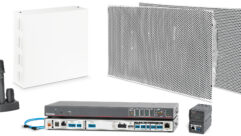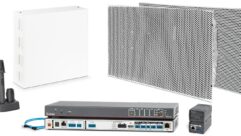
MIX-AND-MATCH INTERFACES
Mar 1, 2002 12:00 PM,
BILL WHITLOCK
AUDIO INTERCONNECTION BETWEEN BALANCED and unbalanced equipment
seems to be a murky area for most users, technicians and system
designers. The topic accounts for a surprisingly large portion of the
calls received by the applications engineers at my company (Jensen
Transformers.)
Confusion, even controversy, is further fueled by some published
guides whose technical basis is dubious at best. This column will
briefly explain the underlying engineering principles and offer some
wiring diagrams for interfaces that solve the potential problems that
await the unwary.
DEFINING OUR TERMS
what do the terms balanced and unbalanced really mean
in a systems engineering sense? I’ve done considerable writing and
occasional ranting about the true nature of balanced interfaces, so
I’ll just summarize the most important point: The status of balance
is defined by the impedances of the two signal conductors with respect
to another reference point, usually ground. [See Whitlock,
“Balanced Lines in Audio — Fact, Fiction, and
Transformers,” Journal of the AES, Vol. 43, No. 6, June
1995. Included in Shields and Grounds from the AES online store
at aes.org/publications/other.cfm#5.]
An unbalanced interface exists when one of the signal
conductors is tied to ground (zero impedance) and the other has some
higher impedance. Unbalanced inputs and outputs are very popular in
consumer electronics, electronic musical instruments and low-cost
professional audio equipment (often called semi-pro). The ubiquitous
RCA and other connectors are widely used for unbalanced audio
interfaces. Examples of typical audio driver (output) and receiver
(input) circuits are shown in the figures here.
Unbalanced interconnections are inherently prone to noise because
the grounded conductor, which most often also serves as the cable
shield, is not only part of the signal circuit, but also a path for
small power line currents. These unavoidable power line leakage
currents will always flow in any wire connecting pieces of equipment
together. In an unbalanced interconnection, as these currents flow
through the resistance of the grounded (shield) conductor, the
resulting voltage drop is directly added to the signal voltage. This
common-impedance coupling causes virtually all hum and buzz
problems in unbalanced interfaces. [Whitlock, Interconnection of
Balanced and Unbalanced Equipment, Jensen Application Note AN003,
download at jensentransformers.com/an/an003.pdf.] Such problems
are rarely due to inadequate shielding of the cable. This is an
incorrect notion reinforced by many authors and cable suppliers.
A balanced interface exists when the two signal conductors
have equal impedances to ground. Balancing is a powerful technique in
eliminating potential system noise. In an earlier era, the presence of
balanced inputs and outputs essentially defined professional equipment.
Because the line impedances are equal, external noise or interference
induces equal voltages in them, making it common-mode voltage.
Since a balanced input responds only to the voltage difference between
the lines, it responds only to the signal voltage and is unaffected by
the common-mode noise or interference voltage. Of course, in the real
world, this rejection is less than perfect for various reasons.
Nowadays, because of low cost, most balanced inputs consist of the
simple differential amplifier circuit shown in the figures, or some
variation of it. The pairs of resistors at each input are well matched,
sometimes trimmed to within 0.01%, in order to nullify circuit response
to common-mode voltages. When used in real-world systems, however, a
major drawback of this circuit is its exquisite sensitivity to the
slightest imbalances in the output (Rs) impedances of the line driver,
which are effectively in series with its inputs. Very often, an input
that touts impressive common-mode rejection ratio (CMRR) specs
has a disappointing performance when connected to a real-world signal
source instead of a precision signal generator.
Balanced output circuits vary widely, but the one shown in the
figures is fairly common. This output circuit provides two symmetrical
signals: i.e., they have equal magnitude but opposite polarity. The
output impedances to the lines are equal. Note that symmetrical signals
in this, or any other, balanced line driver have absolutely
nothing to do with noise rejection.
Resistors typically have tolerances of ±5%, and capacitors
typically have tolerances of ±20% or worse. As noted above, the
balance of these output impedances strongly affects the actual CMRR of
most balanced inputs. Few equipment makers seem to recognize the
importance of this effect. Transformers enjoy a tremendous advantage
over conventional active input stages with regard to their tolerance
for these normal variations in driver impedances.
UNBALANCED-TO-BALANCED INTERFACES
i’d like to direct your attention first to Figure 1B. This schematic
shows a commonly used, but noise-prone, method using 2-conductor
(shielded single conductor) cable and an RCA-to-XLR adapter at the
input. Do not use this adapter — it results in zero ground noise
rejection. All the potential noise-reduction benefit of the balanced
input is wasted. Sadly, many commercial cable assemblies are wired
exactly this way.

Figure 1A shows a much better way to connect an unbalanced output to
a balanced input. Sometimes called a pseudo-balanced connection,
this method allows power line leakage currents to flow in the shield of
a 3-conductor (shielded twisted pair) cable. This allows the balanced
input to sense the signal at the unbalanced output and reject the
common-mode ground noise. The 470-ohm impedance of the unbalanced
output will degrade the 60Hz CMRR of the typical balanced input to
about 30 dB, but that’s still 30 dB better than using the adapter! For
all intents and purposes, using a pseudo-balanced connection is
the correct way to connect an unbalanced component to a balanced
one. Now, let’s look at the best way to add a transformer into the
system.

Adding a Transformer. The interface in Figure 1C uses a conventional
transformer to improve the impedance balance. This will reduce the CMRR
degradation of the balanced input stage at low frequencies. In this
circuit, CMRR will be about 55 dB at 60 Hz, but because of the
inter-winding capacitance in the transformer, CMRR will gradually fall
to about 30 dB at frequencies over 1 kHz. Compared to the correct
adapter cable of Figure 1A, it doesn’t improve buzz, which contains
many high-frequency components, but it does reduce 60Hz hum by another
25 dB.

With rare exceptions, transformers used in hum eliminator boxes are
conventional designs that don’t include a Faraday (electrostatic)
shield between the windings to prevent capacitive coupling between
primary and secondary windings.
The interface in Figure 1D uses a Faraday-shielded, or
input-style, transformer to improve the tolerance of the input
stage to impedance imbalances. The input transformer, unlike the input
stage itself, can tolerate large source impedance unbalances with very
little CMRR degradation. In this circuit, CMRR will be about 100 dB at
60 Hz and 70 dB at 3 kHz, making it very effective at eliminating both
the hum and buzz components. (Faraday-shielded transformers are used in
most Jensen ISO-MAX isolator boxes.)

None of the interfaces shown in these figures provides the 12dB gain
necessary to increase the nominal -10dBV (316 mV) consumer reference
level to the nominal +4dBu (1.23V) professional reference level. In the
rare case where the pro equipment doesn’t have enough available gain,
an active amplifier may be necessary.
One might ask, “Why not use a 1:4 step-up transformer to get
the voltage gain?” A step-up transformer, even if ideal (i.e.,
without any loss) is not a viable source of gain in this application.
Reflected impedances cause excess loading of the consumer output,
leading to an actual loss of gain, compromised low-frequency response
and increased distortion. [Whitlock, “Audio Transformer
Basics,” Handbook for Sound Engineers, Third Edition, Glen
Ballou Editor, Focal Press, 2002, Chapter 11, pp. 254-256.]
BALANCED-TO-UNBALANCED INTERFACES
Connecting a balanced output to an unbalanced input is much more
problematic. Balanced equipment uses a wide variety of output circuits.
The type shown in Figure 2A and Figure 2B can be damaged when one
output is grounded. Others, including most popular servo-balanced
output stages, may become unstable and oscillate or produce distortion
unless one output is grounded right at the driver. But such a ground,
along with the existing one at the unbalanced input, simply reduces the
interface to a completely unbalanced one. Therefore, all benefit of the
balanced output is negated. That’s why an external ground isolator
transformer, such as the one shown in Figure 2A, is a foolproof method:
It works with any kind of balanced or unbalanced output.


In the circuit of Figure 2A, CMRR will be about 60 dB at 60 Hz, but
will decrease at higher frequencies. Again, conventional transformers
are effective for hum but not for buzz. The 2-resistor pad provides 12
dB of signal attenuation to reduce pro levels to consumer levels.
The circuit of Figure 2B uses a 4:1 step-down (12 dB of attenuation)
transformer with a Faraday shield, which results in an outstanding CMRR
of about 120 dB at 60 Hz and 85 dB at 3 kHz, which is effectively an
elimination of both both hum and buzz. Generally speaking, any
Faraday-shielded transformer must be located close to the input it
feeds because the capacitance of a long cable run can seriously affect
frequency response.
Bill Whitlock is president of Jensen Transformers Inc. He has
designed audio and video circuits and systems for 30 years. He can be
contacted by e-mail at [email protected].









